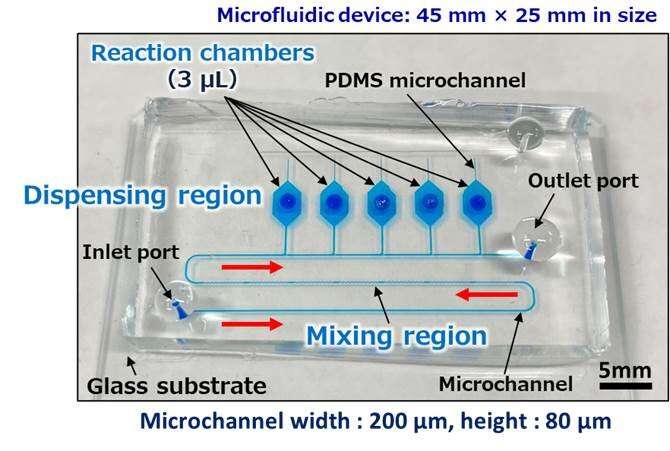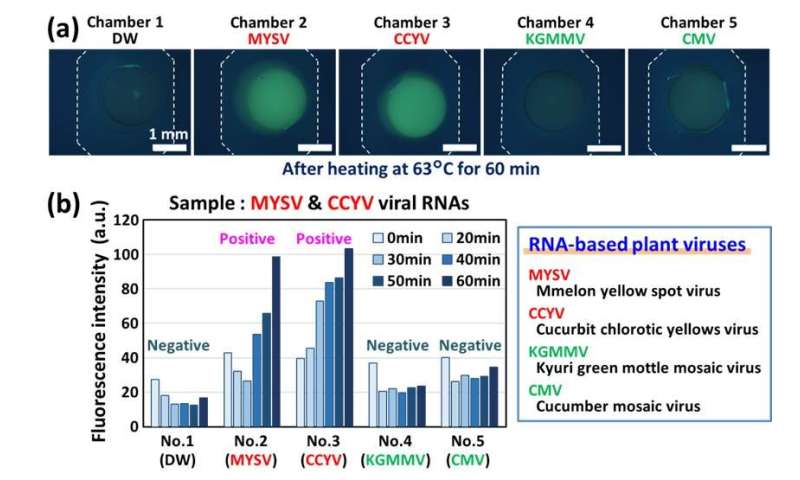A research group composed of Professor Takayuki Shibata and his colleagues at the Department of Mechanical Engineering, Toyohashi University of Technology has applied a microfluidic chip technology to develop a multiplex genetic diagnostic device for the early detection and prevention of crop diseases. The group conducted a gene amplification experiment using four kinds of cucumber viruses on the palm-size diagnostic device, and successfully demonstrated that the rapid multiplex diagnosis can be performed within 1 hour of testing. This diagnostic device is a highly versatile technology that can be used for genetic diagnosis not only in viral diseases of crops, but also in various areas including human infections (e.g., the agriculture/livestock/fisheries industries, the food industry, and health/medical care).
With increased food demand due to world population growth and decreased production due to abnormal weather as a backdrop, the “steady supply of safe and high quality agricultural, forest, and fishery products and food” has become a pressing issue common to all humankind in order to actualize a sustainable world (Sustainable Development Goals, SDGs). This research aims at developing a diagnostic technology to support the effective and stable production of high quality crops. By utilizing this technology, even regular agricultural producers without special knowledge or skills can easily and rapidly test for plant diseases and insect pests at their farms at the genetic level.
Loop-mediated isothermal amplification (LAMP) is one of methods for detecting target nucleic acids (DNA or RAN). This approach can amplify the targeted gene at a constant temperature (60-65ºC for 30 minutes to 1 hour) without expensive instrumentation for high-precision temperature control in PCR assays, which is the most commonly used genetic diagnosis technique. Therefore, the LAMP method has considerable potential for providing an easy-to-use diagnostic tool and enabling on-site diagnoses. However, the conventional LAMP assay is troublesome in that it is necessary to prepare and test as many sample (the DNA or RNA targets)/reagent mixtures individually for each targeted virus. This process also requires specialized knowledge and skills.
-

Photograph of multiplex genetic diagnostic device. Credit: TOYOHASHI UNIVERSITY OF TECHNOLOGY.
-

The simultaneous detection of multiple RNA-based plant viruses (MYSV and CCYV) (Fluorescence intensity increased only in reaction chambers No.2 and No.3 corresponding to target viruses) Credit: TOYOHASHI UNIVERSITY OF TECHNOLOGY.
Here, our research team has solved this problem by employing microfluidic chip technology. We have developed a polydimethylsiloxane (PDMS)-based microfluidic device for the multiplex genetic diagnosis of plant diseases by using semiconductor manufacturing technology. The fabricated multiplex genetic diagnostic device consists of an array of five reaction chambers (3 μL in volume) and a microchannel (200 μm in width and 80 μm in height) forming a network connecting them. The device was approximately 45 mm×25 mm in size (less than 1/3 of name card). As a sample, total RNA containing viral RNA target extracted from diseased cucumber leaves collected at a farm was used. In the operating procedure for the multiplex LAMP assay, a mixture of sample and reagents were autonomously dispensed into the multiple reaction chambers, with just one operation for introducing the mixture into the inlet port of the device. Then, the device was heated in hot water (63ºC for 40 minutes to 1 hour), resulting in the specific amplification of targeted nucleic acids. As shown in the figure, two kinds of RNA viruses were successfully detected simultaneously on our diagnostic device. It should be noted that the device has the ability to simultaneously diagnose up to four different kinds of plant viral diseases.
We will develop a diagnostic device for enabling the simultaneous detection of a total of eight items, including four kinds of cucumber viral diseases and four kinds of insect pests, with the aim of putting the device to practical use. In principle, it is possible to freely customize the types of target viruses to meet individuals’ specific needs on our diagnostic device. Therefore, looking ahead to the “life with corona” era, we will provide a platform for the rapid multiplex diagnosis of human infectious diseases (such as the novel coronavirus and the influenza viruses). We will also realize the rapid multiplex allergen testing in food production (seven specified raw material items: wheat, buckwheat, peanut, egg, milk, shrimp, and crab) as food safety technology.
Daigo Natsuhara et al, A Microfluidic Diagnostic Device Capable of Autonomous Sample Mixing and Dispensing for the Simultaneous Genetic Detection of Multiple Plant Viruses, Micromachines (2020). DOI: 10.3390/mi11060540
Citation:
Microfluidic chip technology enables rapid multiplex diagnosis of plant viral diseases (2020, August 21)
retrieved 22 August 2020
from https://phys.org/news/2020-08-microfluidic-chip-technology-enables-rapid.html
This document is subject to copyright. Apart from any fair dealing for the purpose of private study or research, no
part may be reproduced without the written permission. The content is provided for information purposes only.
